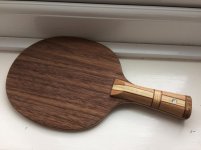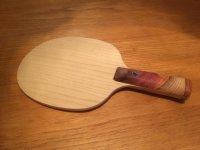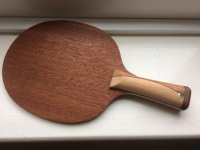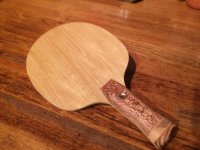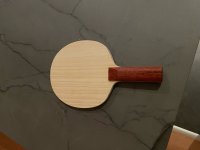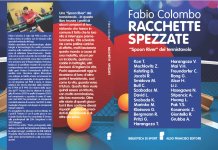I thought it was worthwhile feeding back on the tests that have been done on the hide glue blades I've recently made.
Can I point out that this was not completed using any scientific based research methodology but during a few training sessions and practice matches so please consider this my subjective and personal findings! Similar rubbers where used on all the blades - Tibhar Genius mainly.
I've made five blades with hide glue:
Blade 1 - Kiri - Mahogany - Walnut - off
View attachment 14594
Blade 2 - Kiri - ash - ash - all/all+
View attachment 14595
Blade 3 - Kiri - ayous - mahogany - off
View attachment 14596
Blade 4 - ayous - fir - limba - all+/off-. This has an experimental anatomic handle, which turned out Ok.
View attachment 14597
Blade 5 - Ayous - spruce - walnut - picture to follow! off-
Here's what I found, first from a blade maker's perspective:
Good points
1) Great bond, probably better than any other glue I've used and this includes PVA, PU and Epoxy.
2) Reversible - I think we all know this one. However, very useful. I had a slight issue with a spot where I must have missed the glue, I took a hairdryer, heated it up and pushed the glue underneath in place and it worked perfectly.
3) Easier than most glue types to clean up
4) The glue is quite light in weight. As it's water based it evaporates leaving a really good bond but light. I would estimate around 2 or 3g lighter for a standard blade than most glue types. Similar to PVA in weight.
Bad points:
1) It needs plenty of effort to work with. You have to soak the pearls the night before, it needs to be heated slowly and kept at temperature. You also need to get the water to glue ratio spot on too.
2) You need the right equipment. I'm lucky as I managed to get an old double boiler glue pot and this helped tremendously.
3) Not all hide glues are the same - make sure you get high quality luthier's glue. Some require different water ratios too and they don't always come with that information.
4) You have to make a new batch every time. I kept one batch that I had left over and after 4/5 days mould spots appeared. Maybe storing in the fridge may help but it does have a slightly unpleasant odour so my wife wasn't too keen!
How do they play? Three other players were involved in the testing:
1) The feel appears to be the key selling point of hide glue blades and this came out with my blades too. It's certainly softer. There are some vibrations but they appear to be quite muted and certainly not unpleasant in any way. I have found feel to be very personal. One player absolutely loved the feel and another felt it was Ok, nothing special.
2) I would suggest it's slightly slower that the harder glues such as PU and Epoxy and this would tie in with the softer feel.
3) It's fantastic in the short game. Pushes and flicks are great and I (and others) felt they had complete control and accuracy here.
4) There is an extra gear to be found especially in the walnut outer blades. When trying to finish a point there is some extra speed to support
5) Great for looping. The glue is quite elastic and allows for better flex than many other glue types resulting in blades with great looping capabilities.
In summary, hide glue is time consuming to use but not unpleasant, I like the fact it's a natural product but in needs care and attention - i can see why hide glue blades are more expensive, the glue is cheap but the time needed is much greater.
For me, there are two types of player who will enjoy this type of blade:
1) Controlled loopers who attack but aren't trying to kill every ball. Here you need the offensive style blades - the walnut outers above.
2) Those who like to control the opponent through the short game - those who like to push a lot but like to attack when the ball 'pops up'. The example would be the ash or limba blades above.
If you're game is power-based and you rely on smashing, flat hitting etc then I personally wouldn't recommend a hide glue blade. Obviously this all depends on what rubbers you use.
I do plan to make a off+ hide glue blade using harder outers however I'm now working with a TTD member experimenting with carbon blades which is a different approach with different challenges.























